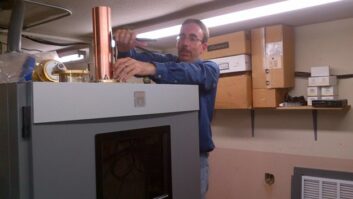(click thumbnail)The Jump is installed in a place of honor with its suction cup mount, right next to the author’s two-meter radio. Photos by Tom Ray.I have in my possession a Visteon HD Jump radio. My review in the car is based on comparison with my benchmark, a Kenwood KTC-HR100TR. My table benchmark is a Directed Electronics Table Top HD Radio.
My AM observations are with the WOR signal, which I know well. My FM observations are on several stations transmitting off of the Empire State Building.
Who is Visteon? Chances are, you have used a Visteon radio before and you just didn’t know it. Visteon makes most of the factory-installed radios found in Ford vehicles, among others. The company also manufactures numerous aftermarket auto electronics products.
Several mounting methods
The Visteon HD Jump is designed to be similar to a Sirius Satellite Radio or XM Satellite Radio. It is slightly larger than the Delphi XM SkyFi radio. The HD Jump is designed to be used in the car or, when disconnected from its car cradle, in the home with the optional home cradle.
The HD Jump comes with a variety of mounting methods, which made me happy. One is a suction cup mount that mounts the radio directly to the windshield, the method I used.
It also comes with a plastic disk slightly larger than the suction cup, which has a sticky glue on one side. This disk can be placed virtually anywhere on hard plastic, such as the dashboard or console, and the suction cup will stick to it.
The HD jump is fairly easy to install — providing you know how to get at the connections on the radio already installed in the vehicle. The radio has two antenna cables, one to connect to the incoming antenna lead, the other to plug into the existing radio’s antenna jack.
When the HD Jump is turned off, it will pass signals through to your existing radio. In this way, you do not lose use of your existing radio, and it will provide less incentive to “Y” the antenna lead, causing illegal emissions if you use the internal FM modulator.
Unfortunately, Joe Consumer will not be able to connect the antenna leads.
It was not a problem for me, as the Kenwood KTC-HR100TR is located in the glove box for easy access. If I had to access the radio in the dash of my 2003 Ford Explorer, I would have needed to pull the front of the dashboard out and unbolt the radio to do so.
The power lead is intended to be connected directly to the fuse block in the vehicle. I connected it through a cigarette lighter plug. (I have a 12 volt distribution panel in the back seat, as I also have my two-meter ham rig, a GPS unit and an inverter for my laptop all connected in.) The fact that the unit is designed to be connected to the fuse block may be another deterrent to a do-it-yourselfer.
Audio connection to your vehicle can be accomplished in two ways. The first is the internal FM modulator of the HD Jump, the second is a direct audio connection to an auxiliary input to your existing radio.
Adjusted audio output
(click thumbnail)The Visteon HD Jump comes with most everything you need for car installation, including cables, cradle and mounting accessories.I tried the FM modulator, then connected the audio directly into the aux inputs of the Kenwood using a 3.5 mm stereo plug-to-RCA plug cable that I provided. The HD Jump comes with a 3.5 mm stereo plug-to-3.5 mm stereo plug cable to plug into an MP3 aux input on a radio. I think it should also come with an RCA cable.
I live 50 miles north of New York City, and there is only one FM HD Radio station, Cumulus-owned WPDH, in Poughkeepsie, in this area right now. After installing the HD Jump, I set its internal modulator on and set its frequency to 87.9 MHz. I turned the radio on and tuned it to the local FM HD station.
The audio through the HD Jump’s FM modulator was extremely clean and good, and even though you are putting the HD audio through an FM stereo generator with pre-emphasis, you can definitely hear the difference when the HD signal locks. I turned the modulator off and used the aux input on the Kenwood.
I then encountered a problem. The audio from the HD Jump into the aux input was extremely distorted.
The HD Jump’s audio output can be adjusted to three levels, low, medium and high. The high setting produced clipping distortion at the input to the Kenwood. The medium setting was just right, placing the volume control on the Kenwood where I would normally have it.
However, I discovered that, on power up, the audio going into the aux input of my radio was distorted for anywhere from 15 to 45 seconds. This is being caused by a small amount of DC on the audio output of the Jump, and it appears that the input to the Kenwood is either direct coupled or, more likely, capacitively coupled, and there is no way for the caps to equalize quickly to prevent this. An isolation transformer would correct this, but in my mind, this defeats the purpose of a direct connection.
The following morning I headed into the city. I live below the 0.5 mV contour of WOR, and the signal was barely audible. I did note, however, that the normal noise floor wasn’t where it normally is, which is a good thing, and the radio was telling me that WOR was transmitting an HD-R signal.
In Monroe, N.Y., WOR has just about 05. mV, and the signal on the Route 208 bridge over Route 17 is very clean — but the audio was still quiet.
Then the HD Radio decided to kick in.
It almost sent me through the roof of the car, as I had the volume cranked up a good 12–14 dB above normal, and the volume level came up that amount when the radio blended to HD Radio. Guess that’s where the name “Jump” came from, because I sure did. Once I was over the 1 mV contour, the analog levels were fine, as was the HD-R signal.
In direct comparison to the Kenwood, the HD-R performance of the Jump was okay. I drive a route that pretty much follows the null of WOR’s signal, and I noted that the Jump would drop out of HD-R going under bridges and overhead road signs on the upper end of Route 17 in New Jersey, whereas the Kenwood stays locked solid. This could be caused by numerous things in the design of the radio on which I will not speculate.
HD-R performance
PRODUCT CAPSULE
Visteon HD Jump Car/Home HD Radio
THUMBS UP:
Reasonable cost and “palm” sized
Radio can easily be moved indoors; no need to buy a second radio
Can be used with existing car radios
Both car and indoor use kits available
Audio is extremely clean
Can be mounted easily where you want it in the car
THUMBS DOWN:
Radio needs to be professionally installed in vehicles
Noise cancellation circuitry is far too aggressive
Radio runs very hot. Use care where it is put in the vehicle
Needs outboard amplification
Cost: $249 list, available from automotive aftermarket retailers
Web: www.evisteon.com, under Products and Services, then Mobile Electronics
The Jump’s HD Radio performance on FM was very good. The HD-R signals started dropping about 40 miles out, where they tend to drop with the Kenwood, and in a few areas exceeded the range of the Kenwood.
It was here I started encountering a problem that I first thought was AGC-related. It was extremely annoying driving after hitting the HD-R threshold, as the volume and noise levels of the FM signals would vary wildly depending on conditions and multipath. It was almost like being on a roller coaster at times. In strong signal conditions, the HD Jump did not have this problem.
In talking with Bill Wikehart, technical fellow of DSP and radio for Visteon about what I was hearing, it appears the HD Jump is designed with noise canceling circuitry which, in addition to canceling out noise in low signal areas, also reduces the audio level. I told Bill frankly that, while noise cancellation is noble and that I thought the Jump did it well, the audio level reduction was a big problem.
If this is how the public perceives radio with DSP noise reduction technology, I can now understand when someone tells me that “radio sucks.”
When the signal level drops to where it will be noisy but there, and the audio level drops into the mud, Joe Consumer is going to think there is something wrong with the radio station’s signal (possibly one he has listened to for years), and will most likely go to another station when the audio level drops. He probably won’t blame the radio. This could be a big problem for the industry.
In the office, the Jump exhibited the same initial issues, but after settling down, both AM performance with the included AM loop antenna and FM performance with a simple wire antenna were both more than acceptable and equivalent to the benchmark.
The HD Jump is also RDS-compatible. I did note, however, that the RDS data is somewhat downplayed and not “in your face” as the HD PAD data is. This, in my opinion, is sending a subtle message to the consumer that HD-R is superior to analog. I think this is unfair to a station transmitting an RDS signal that for whatever reason has not yet converted to HD-R transmission.
Under strong signal conditions, the audio quality on both AM and FM was extremely good. It has a very clean sounding FM modulator.
The fact you can take the HD Jump with you into the house is a big plus. And the expected price, around $200, is more than fair for what you get.
Unfortunately, I was not able to locate a Web site where the HD Jump was being sold as they tend to be sold through smaller aftermarket auto product dealers and auto dealerships, so I can’t give a street price.
Even though Joe Consumer most likely won’t be able to self-install this radio in his car, it has great potential and seems like a great little radio. If Visteon backs off the aggressiveness of the noise canceling circuitry, this radio could be a consumer hit.









